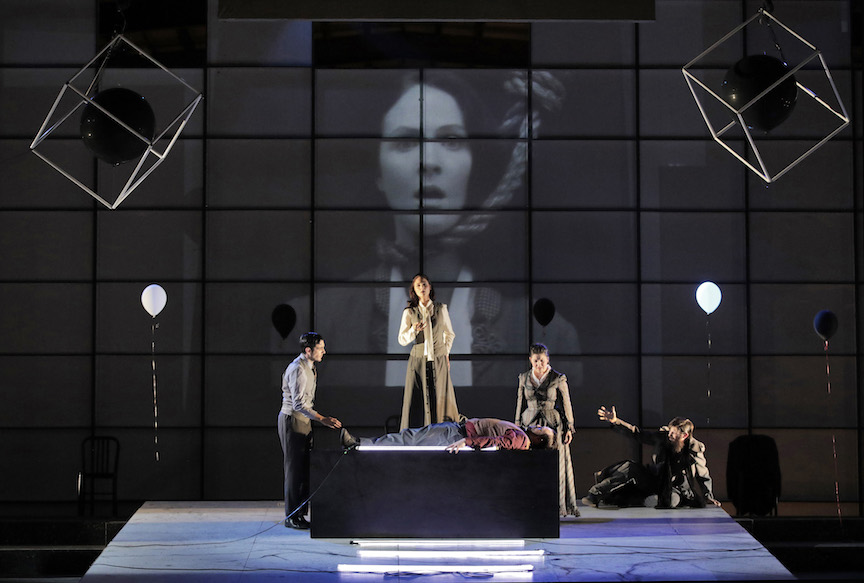Mary Shelley’s enduring Frankenstein
There have been many adaptations of Mary Shelley’s novel, Frankenstein, or The Modern Prometheus. In the past year, SF Ballet mounted a version by British choreographer Liam Scarlett, and Nick Dear’s adaptation was a sensation in London during 2011, with Benedict Cumberbatch and Jonny Lee Miller switching roles between Victor Frankenstein and the Monster.
Neither of these followed Shelley’s work as closely, perhaps, as composer Libby Larsen’s 1990 opera version, one of the three operas presented by the daring West Edge Opera during their Festival 2017.
Larsen begins the story with Shelley’s frame. Victor Frankenstein has been saved from an icy death by Captain Walton, a sea captain who is exploring the North Pole in a bid for scientific fame. Frankenstein, recognizing in Walton a similar ambition and reckless ego, tells him his story. Although Larsen’s libretto uses a pared-down and elliptical text, her comments on the work reveal her intent.
The story, she writes, is about “humankind’s inherent ambition and ego; … temptation to misuse technology in service to intellectual ambition and ego; … terror of loneliness … and the consequences of egocentric action in the name of progress.” These ideas are tersely delivered in the Scene titles: Impulse, Curiosity, Arrogance, The Act, etc. It doesn’t, however, address the monster’s potential for humanity, or the mediating effects of kindness.
She spins her ideas emotionally through her remarkable music, which runs the musical and sound gamut. In Music Director and Conductor Jonathan Khuner’s words: “Her chamber-orchestral palette varies from tender blends of string and wind groups to strident tone cluster and extreme registers.” All of which cohere into a sonic whole, creating an icy world reminiscent of the opera’s opening prolog.
Each year this company gets better and better. The singers were splendid. Tenors Sam Levine and Daniel Curran were Frankenstein as the young scientist who creates a life he cannot love and as the broken man saved from an Arctic death. At times in the opera they appear together debating over the horrific events caused by Frankenstein’s monster. Larsen’s device is a little clunky, and at times I thought I was in the wrong Gothic novel.
Soprano Chelsea Hollow sang Frankenstein’s love Elizabeth; bass-baritone Josh Quinn sang Captain Walton; Justine, the family’s nanny, was sung by mezzo-soprano Veronica Jensen; baritone Ryan Bradford sang Henry Clerval, the scientist’s childhood friend. Rowan Whitney was little brother William.
The opera has several musical interludes. The long scene “What the Monster Saw” is only instrumental, and West Edge conforms to Larsen’s original concept of presenting a video enactment of how the world appears to this newly born creature, which has an adult form but an infant’s perception. Video throughout was by Jeremy Knight, who regularly provides media backgrounds for the company. The opening black-and-white videos of the stark world that Walton and Frankenstein inhabit are especially resonant. Jean-François Revon did the set design.
The Monster was embodied by the dancer Gary Morgan, who is an Oakland Turf dancer, a later manifestation of B-Boy dancing, which developed in Oakland. It was a rather brilliant choice for the speechless creature who suffers from the rejection of his creator and the alienation imposed by a society that flees from him, and which he kills in return. Morgan is a talented dancer, whose fluid robotics gave the Monster a terrifying lyricism, due to his extraordinary and almost inhuman physical flexibility. Although improvisation is part of Turf dance practice, a good choreographic eye would have helped give the dance more impact and less repetition.
Like the dance, the movement onstage had patches of aimlessness, but for the most part the stylized directing by Matthew Ozawa gave a formal precision to the story that mirrored the tension between reason and emotion, locking all the characters into alienation and a subterranean despair.
The orchestra under Khuner’s baton was resilient and on point. Singers and orchestra were aided by the excellent acoustics of the venue, The Pacific Pipe Company, the ramshackle warehouse that West Edge moved to when the City of Oakland condemned their last venue, the Oakland Train Station. The rusty girders, massive space and graffiti covered walls added to the ambience of the story, and gave the company a huge stage and heaps of character for this year’s Festival.
– Jaime Robles
Photo: Ryan Bradford (Henry Clerval), Veronica Jensen (Justine), Chelsea Hollow (Elizabeth) and Daniel Curran (Ship Victor). Photo by Cory Weaver.

